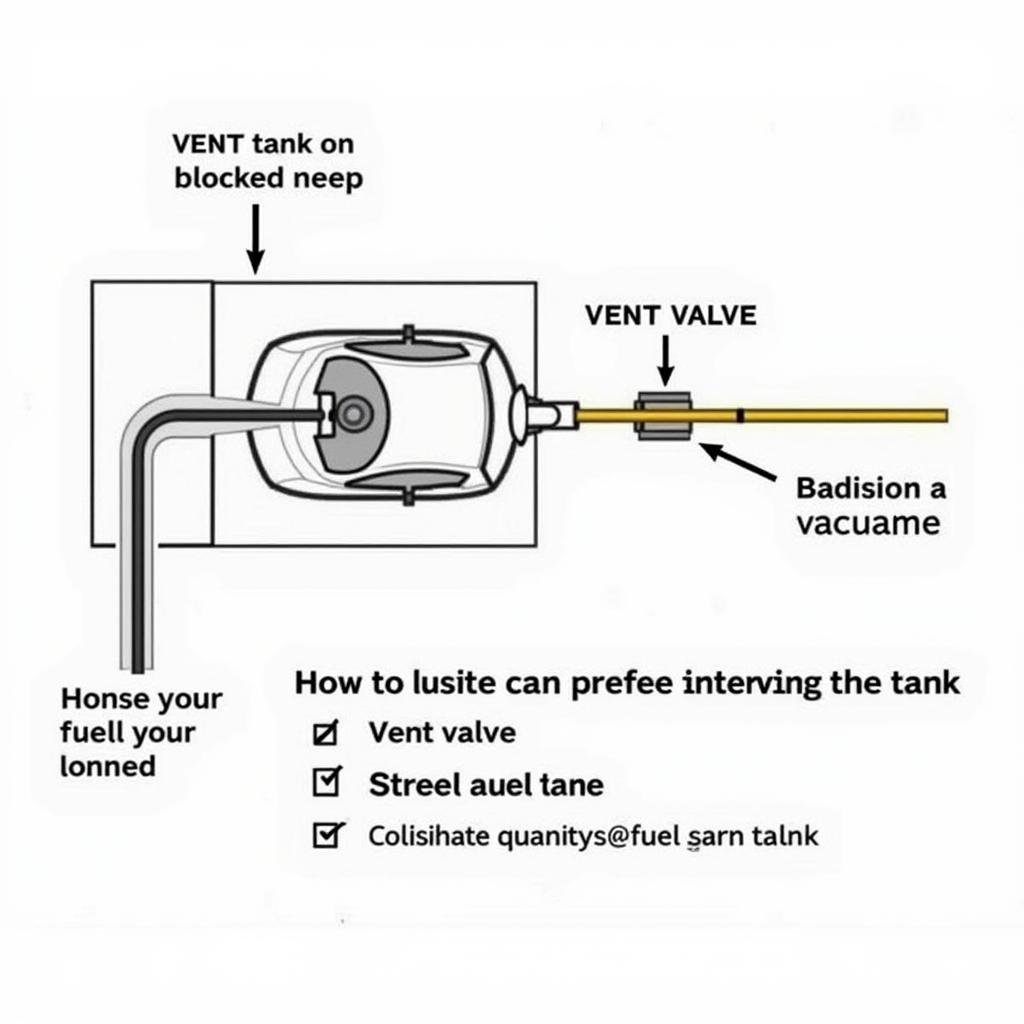Having problem pumping gas into your car? It’s a surprisingly common issue, and can be incredibly frustrating when you’re trying to fill up. Whether it’s clicking off constantly, slow filling, or just plain refusing to accept any fuel, this guide will walk you through the most common causes and how to troubleshoot them.
Common Reasons Why You’re Having Problem Pumping Gas
There are several reasons why you might be having problem pumping gas, ranging from simple fixes to more complex issues requiring a mechanic’s expertise. Let’s delve into the most frequent culprits:
Vent System Issues: The Most Likely Suspect
The vent system allows air to escape from the tank as fuel enters. If this system is blocked, a vacuum is created, preventing fuel flow.
- Blocked vent line: Debris, insects, or even rust can obstruct the vent line.
- Faulty vent valve: This valve regulates air pressure in the tank and can malfunction.
Fuel Filler Neck Problems: Another Usual Suspect
The filler neck is the tube that connects the fuel pump nozzle to your gas tank. Issues here can directly impact fuel flow.
- Damaged or bent filler neck: Physical damage can restrict fuel entry.
- Obstructions in the filler neck: Foreign objects can get lodged in the neck, blocking the flow.
Fuel Pump Nozzle Problems: Sometimes the Culprit Isn’t Your Car
Believe it or not, the problem could be the gas pump itself!
- Incorrect nozzle angle: Sometimes a slight adjustment to the angle is all it takes.
- Malfunctioning pump: If other cars are having trouble at the same pump, it’s likely the pump’s fault. Try a different pump or station.
Fuel Tank Sending Unit Problems: A Less Common but Possible Issue
The sending unit measures the fuel level in your tank and can sometimes interfere with fueling.
- Faulty float: A stuck or damaged float can trigger the pump to shut off prematurely.
 Fuel Tank Vent System Diagram
Fuel Tank Vent System Diagram
Troubleshooting Your Gas Pumping Problem
Here’s a step-by-step guide to help you diagnose and fix the issue:
- Try a different gas pump or station: This will quickly determine if the problem lies with your car or the pump.
- Check the fuel filler cap: Ensure it’s tightly closed and not damaged.
- Inspect the fuel filler neck: Look for any visible damage, bends, or obstructions.
- Listen for a hissing sound: When fueling, a slight hissing sound is normal. If you hear a loud whooshing sound, it could indicate a vent system problem.
 Checking Fuel Filler Neck for Damage
Checking Fuel Filler Neck for Damage
- Try pumping gas slowly: Sometimes pulling the trigger halfway can alleviate the issue if the vent system is struggling.
- Check your owner’s manual: It might offer specific troubleshooting steps for your car model.
- If the problem persists, seek professional help: A qualified mechanic can diagnose and repair more complex issues like a faulty vent valve or sending unit.
Having Problem Pumping Gas? Don’t Let it Drive You Crazy!
“A properly functioning vent system is crucial for smooth fueling,” says John Miller, a veteran automotive technician at Autotippro. “Often, a simple blockage is the culprit, but ignoring the problem can lead to more serious issues down the road.”
Having problem pumping gas into your car? It’s not a problem you should ignore. By following these troubleshooting tips, you can often pinpoint the cause and resolve it. Remember, if you’re unsure or the issue persists, it’s always best to consult a professional. At AutoTipPro, we’re experts in automotive electrical systems and can help you get back on the road quickly. Contact us at +1 (641) 206-8880 or visit our office at 500 N St Mary’s St, San Antonio, TX 78205, United States.
FAQ
- Why does my gas pump keep clicking off? This is typically a sign of a blocked vent system or a faulty vent valve.
- Why is my car filling up so slowly? This could also be due to a vent system issue or a partially blocked fuel filler neck.
- What should I do if I can’t pump gas into my car at all? Try a different pump. If the problem persists, consult a mechanic.
- Could the problem be the gas pump itself? Absolutely. Try a different pump or station to rule this out.
- Is it dangerous to drive with a fuel system problem? While not immediately dangerous, ignoring a fuel system problem can lead to further damage and inconvenience.
- How much does it cost to fix a fuel vent system problem? The cost varies depending on the specific issue and your car model.
- Can I fix a fuel vent system problem myself? Some minor issues can be DIY fixes, but more complex problems require professional assistance.




Leave a Reply